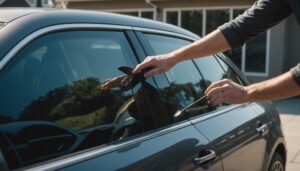Scratches on your car can range from barely noticeable to deep and unsightly. Understanding these differences is key to effectively addressing them. Whether you’re dealing with a minor blemish or a more serious gouge, various methods exist for restoration. Knowing when to opt for DIY solutions, specialized products, or professional help can save you time and money. Let’s explore the best strategies for restoring your vehicle’s finish to its former glory.You can learn more how-to-check-oil-in-car
Key Takeaways
- Assess the depth of the scratch to determine if it’s surface, medium, or deep for appropriate treatment options.
- Use DIY remedies like baking soda paste or toothpaste for light scratches, applying gently with a microfiber cloth.
- Consider scratch removal products specifically designed to fill and blend scratches, following manufacturer instructions for best results.
- Regularly maintain your car’s finish by washing and waxing to prevent deeper scratches from forming.
- Seek professional help for deep or multiple scratches, especially on high-value vehicles, to ensure a flawless restoration.
Understanding Different Types of Scratches

When you’re dealing with scratches on your car, it’s crucial to understand the different types, as each requires a specific approach for effective removal. The most common scratches include surface scratches, which only affect the clear coat and can often be removed with polishing products. Then there are deeper scratches that penetrate the paint layer, which may need touch-up paint or professional repair.
You might also encounter key scratches, caused by deliberate damage, which usually require extensive restoration. Additionally, chip scratches occur from road debris and may demand a paint touch-up to prevent rust. Finally, swirls and micro-scratches, often due to improper washing, can usually be corrected with a fine polish. Knowing the type of scratch you’re dealing with allows you to select the appropriate methods and products, ultimately saving time and maintaining your vehicle’s appearance.You can learn more how-fast-do-f1-cars-go
Assessing the Damage

Before attempting any repair, you should carefully assess the damage to determine the best course of action. Different types of scratches require different treatments, so observing the severity, depth, and location is essential.
Use the table below to help you evaluate the scratch:
| Scratch Severity | Indicators | Recommended Action |
|---|---|---|
| Light Surface Scratch | Visible, does not penetrate base coat | Polishing compound |
| Medium Scratch | Slightly deeper, may reach primer | Touch-up paint or rubbing compound |
| Deep Scratch | Exposes metal or plastic | Professional repair needed |
Evaluate the scratch based on these categories. Understanding these factors will guide you to the appropriate repair strategy, ensuring you tackle the damage effectively and optimize your vehicle’s appearance.You can learn more how-much-is-urgent-care-without-insurance
DIY Home Remedies for Light Scratches

Light scratches on your car’s surface can often be effectively treated with simple DIY home remedies. One popular method involves using baking soda. Mix two parts baking soda with one part water to create a paste, then gently rub it onto the scratch using a microfiber cloth. Rinse and dry the area thoroughly.
Another option is toothpaste, particularly a non-gel, whitening variety. Apply a small amount directly to the scratch, buff it with a soft cloth in circular motions, and wipe away any excess.
If you have a banana peel, it can help too. Rub the inside of the peel over the scratch, followed by a gentle polish with a soft cloth, as the potassium and oils may conceal minor imperfections.
Always test any remedy on a small, inconspicuous area first to verify it won’t damage your car’s finish. Regular maintenance can prevent deeper scratches from forming.
Using Scratch Removal Products
There are several effective scratch removal products available that can help restore your car’s finish. These products typically come in either creams or pens, designed to fill in and blend with the damaged area. To use them, start by cleaning the scratched surface to remove any dirt or grime. Apply a small amount of the product directly onto the scratch. Use a soft cloth to gently rub it in using circular motions, allowing it to fill the scratch.
Many products contain compounds that polish the paint, making the scratch less noticeable. You’ll want to follow the manufacturer’s instructions carefully, as each product may have specific guidelines for application and drying times. Afterward, inspect the scratch to verify it’s smoothed out. For deeper scratches, you may need multiple applications or consider more specialized solutions, including those that even professionals use. Regular maintenance will help keep your car looking its best.You can learn how-to-change-car-battery
Buffing Out Scratches With a Polisher
If scratch removal products haven’t fully restored your car’s finish, buffing out scratches with a polisher is an effective next step. Using a dual-action polisher can help smooth the surface and enhance your vehicle’s appearance. Here’s how to do it:
Buffing out scratches with a dual-action polisher can effectively enhance your car’s finish and appearance.
- Gather Your Materials: You’ll need a dual-action polisher, polishing compound specifically for automotive surfaces, and a microfiber cloth for wiping away residue.
- Prep the Surface: Wash and dry your car thoroughly. Confirm the scratched area is clean to avoid embedding dirt during buffing.
- Buff Carefully: Apply a small amount of polishing compound to the pad, set your polisher to a low speed, and work in overlapping passes. Keep the pad flat against the surface, and use moderate pressure to avoid damaging the paint.
Following these steps will help you effectively buff out scratches, giving your car a polished finish.
Applying Touch-Up Paint
Once you’ve buffed out the scratches, applying touch-up paint is essential for restoring your car’s finish. First, verify the area is clean and dry. Use a mild detergent and water, drying it completely with a microfiber cloth. Choose a touch-up paint that matches your car’s color; check the paint code usually found in the door jamb or owner’s manual. Shake the paint well before use.
Using a fine brush or applicator, carefully apply the touch-up paint directly into the scratch. Start with a thin layer to avoid drips. Allow it to dry as per the manufacturer’s instructions, typically around 10-20 minutes. If necessary, sand the area lightly with fine-grit sandpaper for an even finish, then apply additional layers of paint until the scratch is level with the surrounding surface. Finish with a clear coat for protection, and let it cure completely to verify durability.
Professional Detailing Services
Professional detailing services offer an expert approach to restoring and maintaining your vehicle’s exterior and interior. When you choose to engage these services, you’ll benefit from specialized techniques and high-quality products that effectively minimize the appearance of scratches and enhance your car’s overall aesthetics.
Expert detailing services restore and maintain your vehicle’s beauty, using specialized techniques to minimize scratches and enhance aesthetics.
Here are three key services they typically provide:
- Paint Correction: This process involves multiple stages of polishing that remove surface imperfections, including light scratches, swirls, and oxidation, resulting in a glossy finish.
- Ceramic Coating: A protective layer applied over the paint, providing long-lasting defense against environmental contaminants and enhancing shine.
- Interior Detailing: Deep cleaning of upholstery, carpets, and surfaces, ensuring your vehicle’s interior looks pristine while also removing stubborn stains and odors.
Using professional detailing services not only improves your car’s appearance but also helps maintain its value over time.
Preventing Future Scratches
While regular maintenance and addressing existing scratches are essential, preventing future scratches can greatly enhance your car’s longevity and appearance. Start by investing in a quality car cover; it shields your vehicle from environmental hazards like tree sap, bird droppings, and UV rays. Additionally, park in designated areas or garages whenever possible to minimize exposure to errant carts and door dings.
Consider applying a high-durability ceramic coating or sealant after polishing your car. These coatings provide a protective layer that acts as a barrier against minor abrasions. Moreover, you should keep your car clean by washing it regularly with a pH-balanced car shampoo. This helps eliminate dirt and debris that could lead to scratches during cleaning.
Finally, be mindful of how you handle items around your car. Avoid dragging bags or equipment across the paint. By implementing these strategies, you’ll preserve your car’s appearance for years to come.
Maintaining Your Car’s Finish
To keep your car looking its best, maintaining the finish is just as important as preventing scratches. Regular care and attention can protect your vehicle’s exterior and enhance its longevity. Here are three essential steps you should follow:
- Wash Regularly: Use a pH-balanced car wash solution and a microfiber cloth to avoid damaging the finish. Rinse thoroughly to remove debris before drying.
- Wax Frequently: Apply a high-quality wax every three months. Wax acts as a protective barrier against contaminants and UV rays, helping to maintain that showroom shine.
- Avoid Harsh Chemicals: Stay away from abrasive cleaners and high-pressure washers. These can strip protective coatings and cause surface damage, leading to longer-term issues.
When to Seek Professional Help
When should you consider bringing your car to a professional for scratch removal? If the scratch is deep or has penetrated the clear coat, it’s time to consult an expert. Additionally, if you’re unsure how to assess the damage or feel uncomfortable with DIY methods, professional help is vital.
| Situation | Action Required |
|---|---|
| Deep scratches | Seek professional help |
| Multiple scratches | Seek professional help |
| High-value vehicles | Seek professional help |
Attempting to fix significant damage without the right tools and expertise may worsen the issue. Professionals not only have the skills but also access to advanced materials that guarantee a flawless finish. Remember, your car’s appearance reflects your care, and addressing serious scratches with a professional can restore its value efficiently. Don’t hesitate; your car deserves quality treatment.
Frequently Asked Questions
Can Scratches on Car Paint Affect Its Resale Value?
Yes, scratches on car paint can affect its resale value. Dents diminish appeal, scratches mar aesthetics, and imperfections raise concerns. When potential buyers view your vehicle, their first impression matters; visible scratches can signal neglect or low maintenance. While minor blemishes may lessen the impact, significant damage can lead to lower offers. Maintaining a pristine exterior not only enhances your car’s look but also preserves its value in the resale market.
How Do Weather Conditions Impact Scratch Visibility?
Weather conditions substantially affect scratch visibility on your car. In direct sunlight, scratches may become more pronounced due to reflections, while rain can highlight imperfections by adding contrast. Cold temperatures can cause paint to contract, making scratches more noticeable. Conversely, a cloudy day might mask scratches, reducing their visibility. Regularly washing your car and applying wax can help protect the paint and minimize the impact of weather on scratch visibility.
Is Ceramic Coating Effective in Preventing Scratches?
They say, “An ounce of prevention is worth a pound of cure. Ceramic coating is effective in preventing scratches, as it creates a strong, protective layer over your car’s paint. This layer acts as a shield against minor abrasions, dirt, and UV rays. While it won’t make your vehicle impervious to all damage, it greatly reduces the risk of scratches, keeping your car looking newer and maintaining its value longer.
Can I Use Nail Polish for Minor Scratches?
Yes, you can use nail polish for minor scratches on your car’s paint. Make certain the polish matches your vehicle’s color precisely. Clean the scratched area thoroughly, then apply a thin layer of nail polish with a fine brush. Allow it to dry completely before evaluating the repair. Keep in mind that nail polish isn’t a long-term solution, as it may not withstand environmental factors as well as automotive touch-up paint.
What Household Items Can Help Remove Deep Scratches?
You can use several household items to help remove deep scratches. Baking soda mixed with water creates a paste that can fill in scratches when buffed gently. Toothpaste, particularly whitening types, contains mild abrasives that can polish the area. You can also try using a soft, damp cloth with white vinegar or rubbing alcohol, which may help to lessen the appearance of deep scratches. Always test these methods on an inconspicuous area first.













